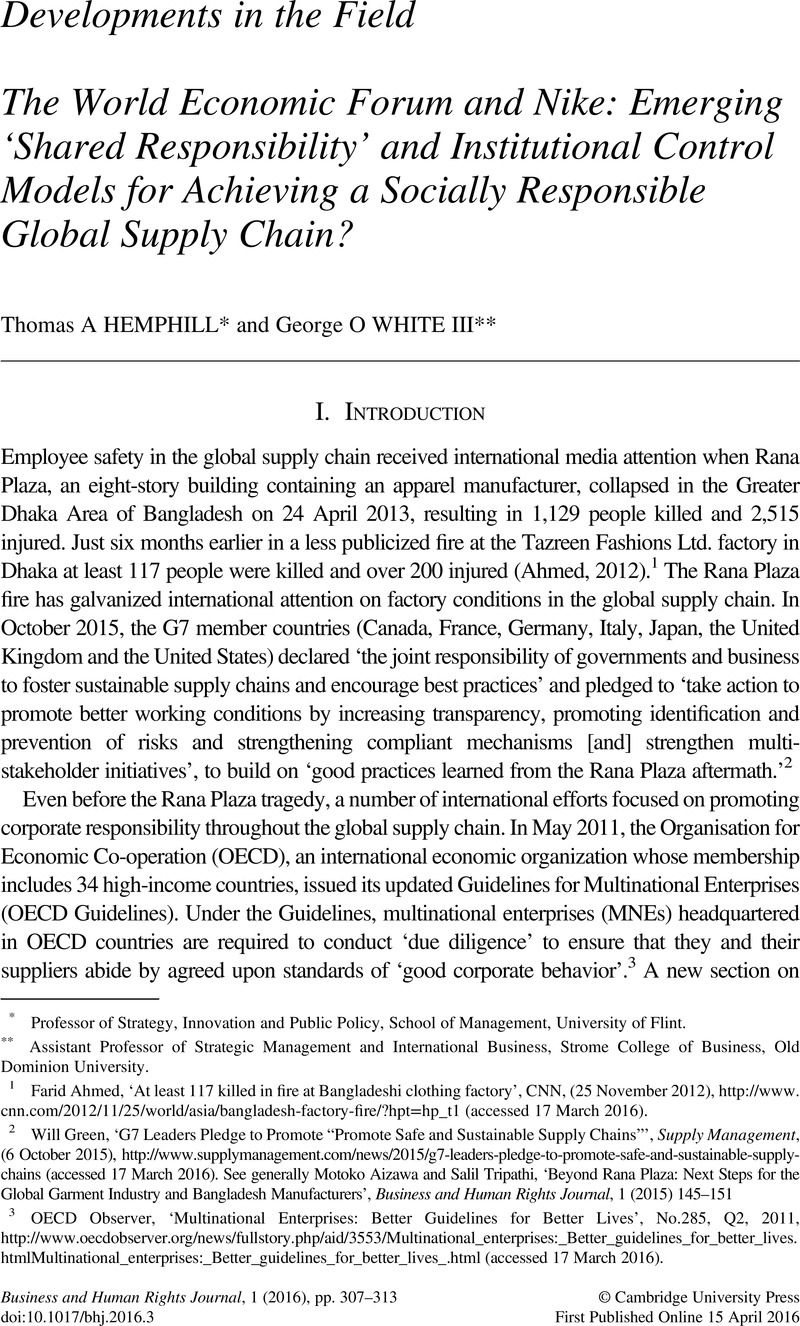Article contents
The World Economic Forum and Nike: Emerging ‘Shared Responsibility’ and Institutional Control Models for Achieving a Socially Responsible Global Supply Chain?
Published online by Cambridge University Press: 15 April 2016
Abstract

- Type
- Developments in the Field
- Information
- Copyright
- Copyright © Cambridge University Press
Footnotes
Professor of Strategy, Innovation and Public Policy, School of Management, University of Flint.
Assistant Professor of Strategic Management and International Business, Strome College of Business, Old Dominion University.
References
1 Ahmed, Farid, ‘At least 117 killed in fire at Bangladeshi clothing factory’, CNN, (25 November 2012), http://www.cnn.com/2012/11/25/world/asia/bangladesh-factory-fire/?hpt=hp_t1 (accessed 17 March 2016)Google Scholar.
2 Green, Will, ‘G7 Leaders Pledge to Promote “Promote Safe and Sustainable Supply Chains”’, Supply Management, (6 October 2015), http://www.supplymanagement.com/news/2015/g7-leaders-pledge-to-promote-safe-and-sustainable-supply-chains (accessed 17 March 2016)Google Scholar. See generally Aizawa, Motoko and Tripathi, Salil, ‘Beyond Rana Plaza: Next Steps for the Global Garment Industry and Bangladesh Manufacturers’, Business and Human Rights Journal, 1 (2015) 145–151 CrossRefGoogle Scholar
3 OECD Observer, ‘Multinational Enterprises: Better Guidelines for Better Lives’, No.285, Q2, 2011, http://www.oecdobserver.org/news/fullstory.php/aid/3553/Multinational_enterprises:_Better_guidelines_for_better_lives.htmlMultinational_enterprises:_Better_guidelines_for_better_lives_.html (accessed 17 March 2016).
4 United Nations Office of the High Commissioner, ‘Guiding Principles on Business and Human Rights: Implementing the United Nations Protect, Respect and Remedy Framework’, 2011, New York, NY and Geneva Switzerland.
5 World Economic Forum, ‘Our Mission’, (23 December 2015), http://www.weforum.org/world-economic-forum (accessed 17 March 2016).
6 World Economic Forum ‘Our Members and Partners’, (23 December 2015), http://www.weforum.org/our-members-and-partners (accessed 17 March 2016).
7 Supply Chain Risk Initiative, ‘New Models for Addressing Supply Chain and Transport Risk’, World Economic Forum (An Initiative of the Risk Response Network in Collaboration with Accenture), January 2011, Geneva, Switzerland.
8 Supply Chain Risk Initiative, ‘Building Resilience in Supply Chains’, World Economic Forum (An Initiative of the Risk Response Network in Collaboration with Accenture), January 2013, Geneva, Switzerland.
9 Manners-Bell, John, ‘White Paper on Business Sustainability: What it is and why it Matters’ (Joint Statement: Global Agenda Councils), 4, World Economic Forum, July 2014, Geneva, Switzerland Google Scholar.
10 World Economic Forum, Beyond Supply Chains: Empowering Responsible Value Chains (Geneva: January 2015)Google Scholar.
11 World Economic Forum, A New Paradigm: Shared Responsibility for Supply Chains (White Paper), 3, Global Agenda Council on Human Rights, Geneva, Switzerland, November 2015.
12 Center for Business and Human Rights, ‘Rana Plaza: Factory Safety and Workers’ Rights in the Apparel Supply Chain Two Years Later’, April 2015, Stern School of Business, New York University, New York, NY, http://bhr.stern.nyu.edu/bangladesh (accessed 17 March 2016).
13 Ibid.
14 Ibid, Shared Responsibility, 4.
15 Ibid, Executive Summary, 3.
16 Debora L spar and Jennifer Burns, ‘Hitting the Wall: Nike and International Labor Practices’, Harvard Business School Case 700047, 19 January 2000.
17 Nisen, Max, ‘Why the Bangladesh Factory Collapse Would Never Have Happened to Nike’, BusinessInsider.com, (10 May 2013), http://www.businessinsider.com.au/how-nike--solved-its-sweatshop-problem-2015-5-10 (accessed 17 March 2016)Google Scholar.
18 Ibid.
19 Sharma, Ariel, ‘Swoosh and Sustainability: Nike’s Emergence as a Global Sustainable Brand’, Supply Chain, (17 May 2013), http://www.sustainablebrands.com/news_and_views/supply_chain/swoosh-and-sustainability-nikes-emergence-global-sustainable-brand (accessed 17 March 2016)Google Scholar.
20 Nike, Inc., ‘Letter from the President and CEO’, Corporate Responsibility Report (2012–13), http://www.nikeresponsibiliy.com/report/content/chapter/letter-from-the-ceo (accessed 17 March 2016).
21 Ariel Sharma, note 19.
22 Banjo, Shelly, ‘Nike CEO on Bangladesh: Is it a Perfect Situation? No’, The Wall Street Journal, (22 April 2014)Google Scholar, http://blogs.wsj.com/corporate-intelligence/2014/04/22/nike-ceo-on-bangladesh-is-it-a-perfect-situation-no/ (accessed 17 March 2016).
23 Nike, Inc., ‘III. Design the Future: Manufacturing’, Corporate Responsibility Report (2012–13), http://www.nikeresponsibility.com/report/content/chapter/manufacturing (accessed 17 March 2016).
24 Ariel Sharma, note 19.
25 Ibid.
26 Ibid.
27 Ibid.
28 Ibid.
29 Ibid.
30 Ibid.
31 Shelly Banjo, note 22.
32 Banjo, Shelly, ‘Inside Nike’s Struggle to Balance Cost and Worker Safety in Bangladesh’, The Wall Street Journal, (21 April 2014)Google Scholar, http://www.wsj.com/articles/SB1000014240527023087360457949350231397942 (accessed 17 March 2016).
33 Ibid.
34 Ibid.
35 One approach to answering this important company values-based question was developed by Levi Strauss & Co., the brand-name apparel manufacturer. In 1993, senior managers in the China Policy Group were deciding whether the company should have a business presence in China, given its human rights problems. Senior management employed the company’s ‘principled reasoning approach’, which is based on the company’s ethical values and newly-adopted global sourcing guidelines, to make a recommendation. This ‘principled reasoning approach’ could be considered as a decision-making model for other companies considering adopting the shared responsibility model. See Lynn S Paine and Jane Palley Katz, ‘Levi Strauss & Co.: Global Sourcing (A)’, Harvard Business School Case 395-127, November 1994 (revised February 1997). The authors thank the editor for this suggestion.
36 Michael S Posner , ‘Disney and Other Big Brands Need to Address the Real Challenges to Outsourcing’, The New York Times, (2 May 2013), http://www.nytimes.com/roomfordebate/2013/05/02/when-does-corporate-responsibility-mean-abandoning-ship/disney-and-other-big-brands-need-to-address-the-real-challenges-to-outsourcing (accessed 17 March 2016).
37 Scott Cooper, ‘Improving Worker Safety in Global Supply Chains: The Case for a Global Safety & Health Management System’, Professional Safety, October 2014, 29–33.
38 Center for Business and Human Rights, note 12.
39 Ibid.
40 Fair Labor Association, ‘Workplace Code of Conduct’, 2011, www.fairlabor.org (accessed 17 March 2016).
41 Ibid.
- 7
- Cited by




